Last Updated: July 22, 2025
Costa Rica’s Guanacaste Province in the northwestern part of the country is a popular spot for surfers and beach goers alike. But many visitors to this relatively flat and dry coastline are also looking to explore some rainforest and volcanoes. Luckily, just a short drive away, there are both. Our family has visited Rincon de la Vieja National Park several times since living in Costa Rica. In this post, we’ll give you everything you need to plan your visit to Rincon, including updated trail conditions.
In this post, we’ll cover the most visited ranger station, Las Pailas. For detailed information on the park’s other entrance, read our post, Rincon de la Vieja: The Lesser Known Santa Maria Sector.
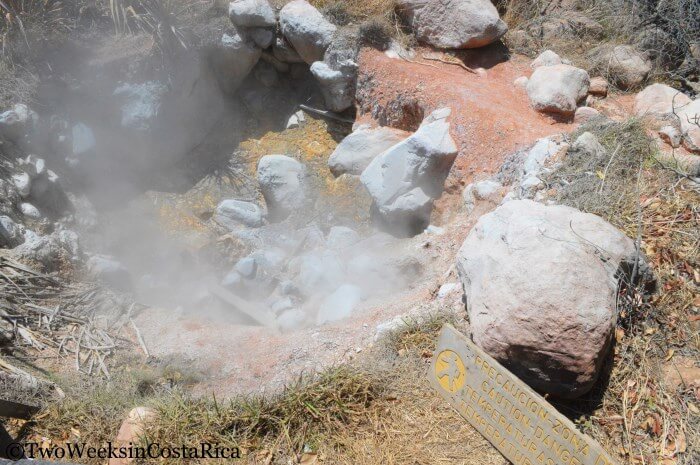
Orientation
Overview
Rincon de la Vieja National Park is a special place because it sits in a part of Guanacaste Province where the flat plains meet the jungle-filled mountains. For this reason, in dry times of year like the busy tourist season (January to April), the forested areas of the park remain green and vibrant.
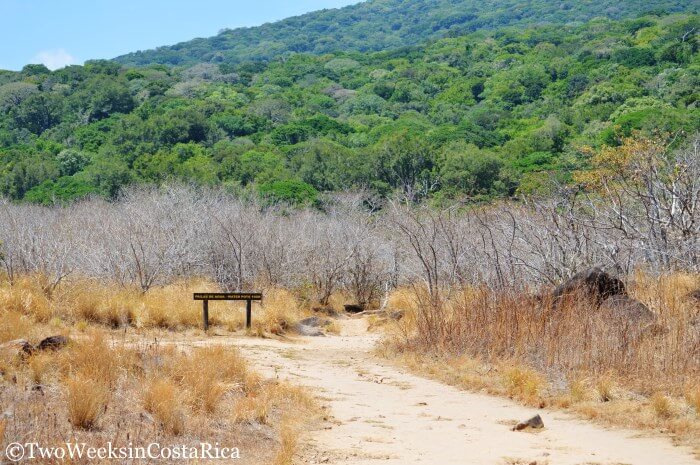
Since there is more vegetation, there are also better chances to spot wildlife like monkeys and tropical birds.
But arguably the biggest draw of Rincon de la Vieja National Park are the many volcanic elements. Active steam vents and bubbling mud pots can be seen right along the trails!
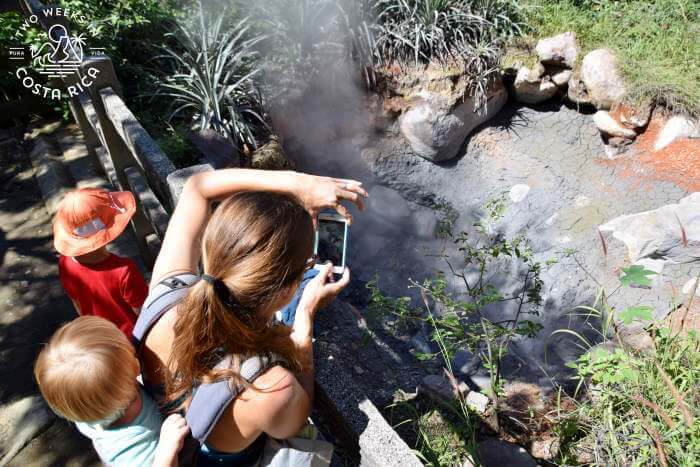
Location
Rincon de la Vieja National Park is located about 25 km (15 miles) northeast of Liberia, the capital city of Guanacaste. It’s about two hours inland from popular beach towns like Tamarindo and Playa Flamingo, and even closer to Playa Hermosa and Playas del Coco (1.5 hours).
The 14,300 hectare (35,336 acre) park has two entrances. One is the Santa Maria ranger station and the other is Las Pailas station. In this post, we cover Las Pailas ranger station, which is a bit easier to access.
For detailed directions to Las Pailas entrance, see the end of this post.
For more information about the Rincon de la Vieja area, including other activities, read our post about the local town, Curubande de Liberia: A Country Town in Rincon de la Vieja.
Overview of Trails at Las Pailas Sector – Rincon de la Vieja National Park
The Las Pailas sector of Rincon de la Vieja National Park has two main trails, the Waterfall Trail and Pailas Trail. A third trail leads to the summit of the volcano but has been closed for several years due to volcanic activity.
Here is a picture of the trail map.
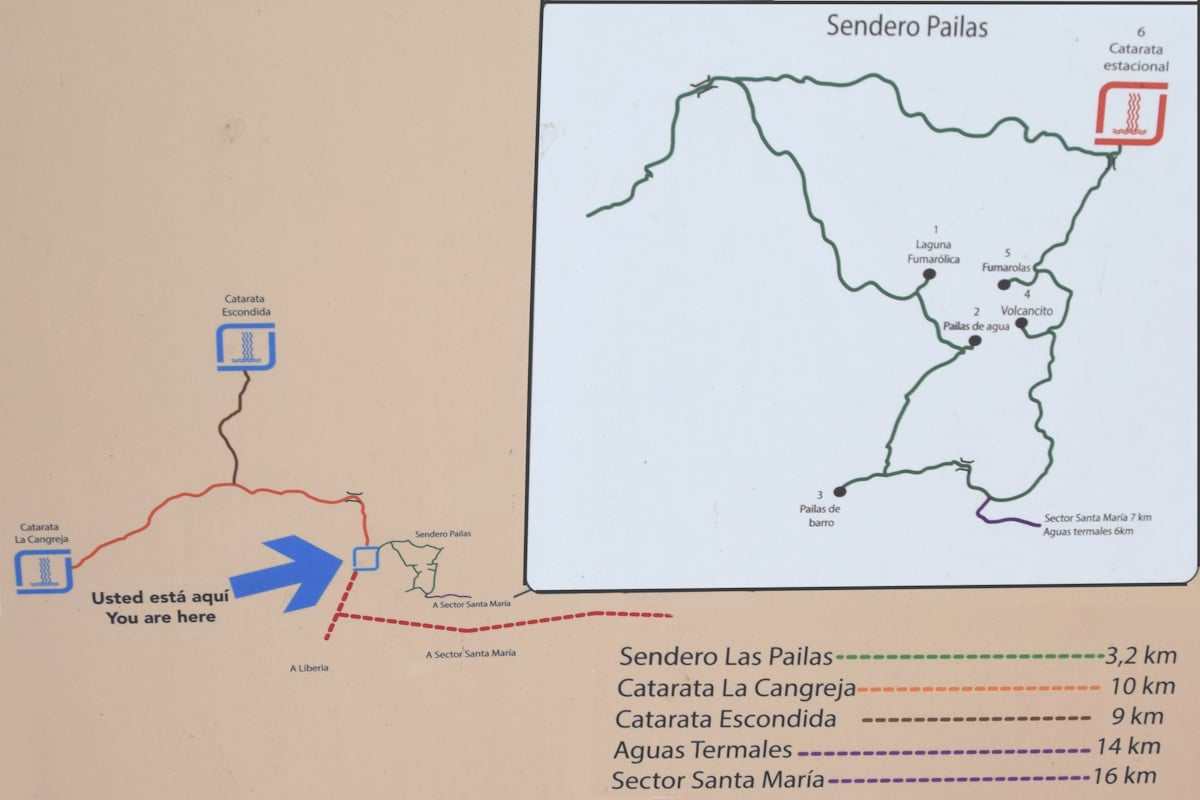
Las Pailas Trail (Most Popular)
Las Pailas Trail is a 3.2 km (2 mile) loop that passes through open fields and then thick rainforest. This is the most used trail because you can easily see volcanic features (more on this below), and the hike isn’t too long.
Expect to spend around 2-3 hours on Las Pailas Trail, going at a leisurely pace. About 45 minutes to 1 hour of that time is spent in almost full sun. Be sure to read our tips on what to bring below.
Waterfall Trail (Longer Hike)
The second trail at sector Las Pailas is the Sendero de las Cataratas or Trail of the Waterfalls. This trail splits into two paths about halfway through, each leading to a different waterfall. The two waterfalls are Catarata La Cangreja and Catarata Escondida.
These trails are longer and more difficult. Combined, they add up to about 18 km (11 miles) roundtrip and would take most of the day for an experienced hiker.
If you’re visiting during rainy season (May through end of November), be sure to ask the ranger about current conditions before you start the hike. Sometimes they close one of the trails due to poor conditions.
Important: Last entrance to the waterfall trails is 12:00 p.m.
Tip: If you want an easier hike to a waterfall, right next to Las Pailas ranger station is the entrance to Oropendola Waterfall. This is a gorgeous cascade that you can swim in during much of the year. It’s only about a 15-minute hike to get there. Read our full post for all the details, Oropendola Waterfall: An Easy-to-Access Waterfall in Guanacaste.
Crater Trail (Closed)
For those hoping to climb to the summit of Rincon de la Vieja, there is a third trail, Sendero Crater Activo or the Active Crater Trail.
Unfortunately, this trail has been closed for several years and will probably remain so for the foreseeable future. This is due to continuous volcanic activity and dangerous gases coming out of the volcano’s crater and vents. Better to stick to the trails around the base of the volcano like Las Pailas.
Las Pailas Trail: Details About the Hike
Las Pailas Trail was recently updated and is now in much better condition.
There are two distinct parts of Las Pailas Trail. The first is a hot sunny field and the second is a shady forest.
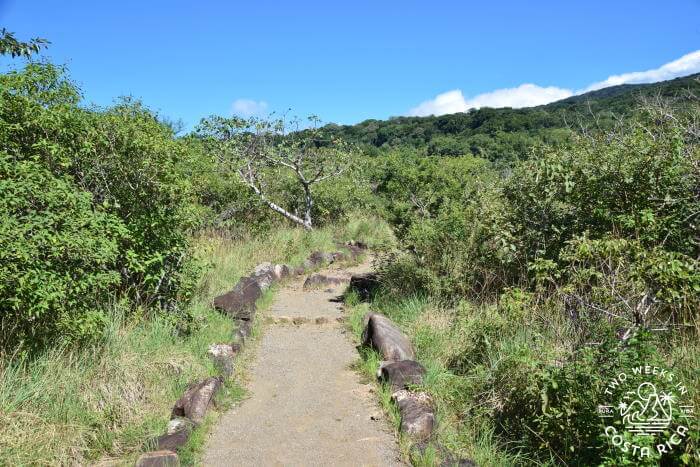
Las Pailas Trail: Part 1 – Open Field
Starting your hike, Las Pailas Trail is a paved path that leads through the shady forest. It crosses a river via a sturdy bridge and brings you to lookout where you can view a volcanic steam vent. This part of the trail is perfect for those with limited mobility as it is well-maintained and fairly easy.
After about 10 minutes, the foliage quickly becomes thinner and the trail gets a little more uneven. It turns to graded dirt with some small steps but remains mostly flat.
In the dry season (January to April), this open field section can become almost desert-like and be extremely hot. We recommend getting to the park in the morning before the heat becomes too intense.
The open field part of the hike is important, though, because that is where a lot of the volcanic activity is seen. Within this section of the trail are three volcanic features.
Check out our short video of the volcanic features
Fumarole Lagoon
The first is a fumarole lagoon (laguna fumarolica). This is where gases and steam come out of a low spot in the ground. The fumeroles can reach temperatures of more than 200˚F (93˚C) so it is really exciting to see them close up. You’ll know you are getting close when you smell the sulfur, which has an odor of rotten eggs.
Acidic Pond
The second feature is a small acidic pond (pailas de agua). The pond has a rich yellow color from volcanic minerals. It looks like something from Yellowstone National Park in the United States. If you look closely, you’ll see gases and steam bubbling up through the water in some places.
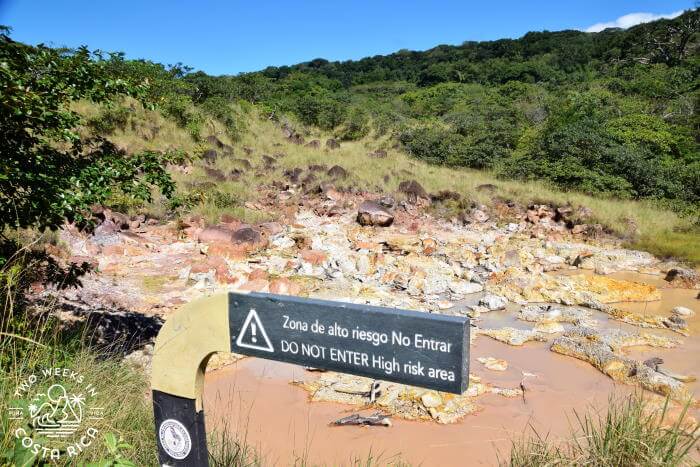
Bubbling Mud Pots
The last feature along this sunny stretch are the mud pots (pailas de barro). Here, gray mud bubbles and boils up from the ground, constantly churning and becoming silky smooth.
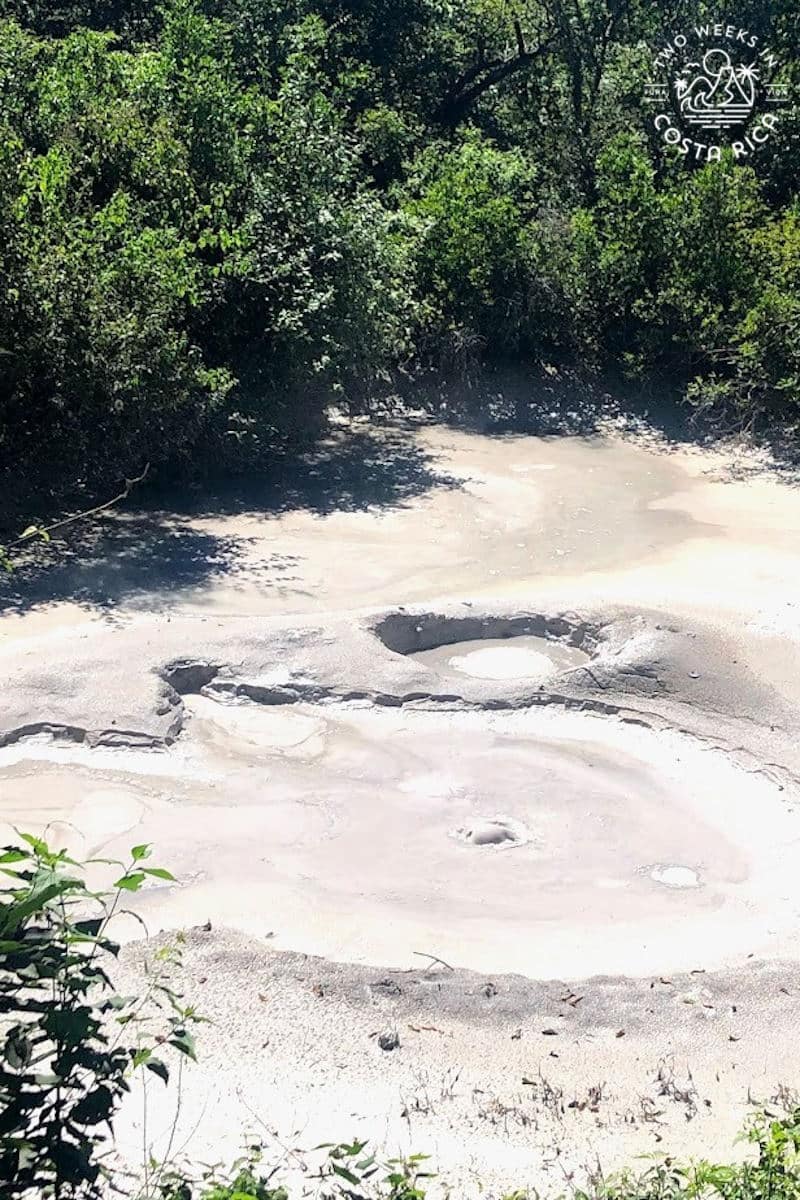
This rich volcanic mud is the same type that is used in spas and at local hot springs for mud baths.
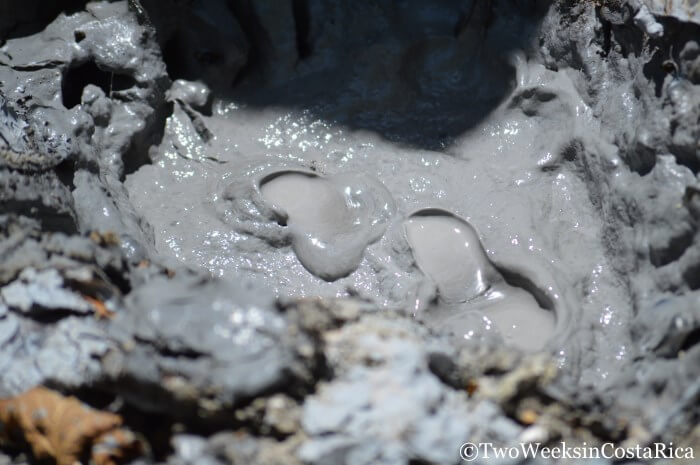
Each volcanic feature is sectioned off with short fences so you can’t get too close. But even from a safe distance, they are impressive. At all the stops, you’ll observe an array of colors and smells caused by the chemical reactions taking place.
Looking to explore more national parks on your trip? Our National Parks articles cover 40+ options all around Costa Rica.
Las Pailas Trail: Part 2 – Shady Forest and a Waterfall
After trekking through the heat and sun, the second part of the Pailas Trail suddenly transitions into much cooler forest. Here, there are more elevation changes and many more steps to traverse. It’s completely worth the effort, though, as you may see some wildlife along the trail.
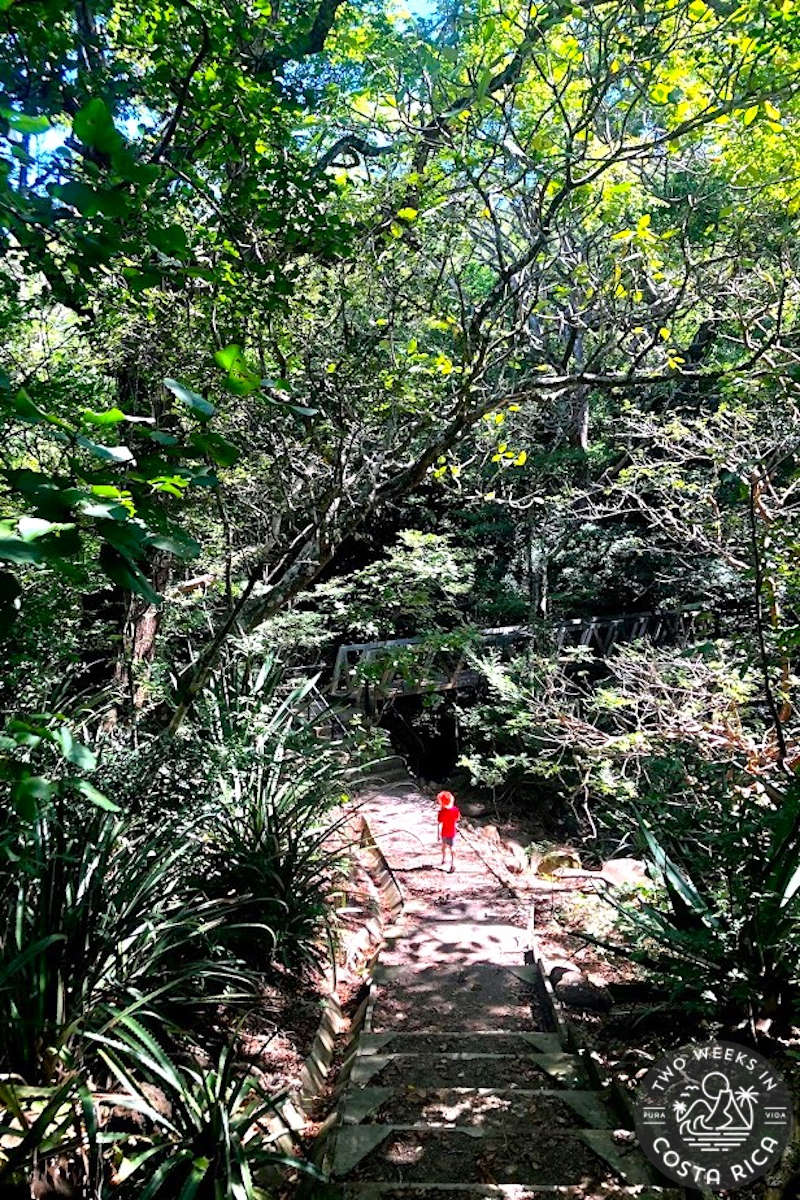
Wildlife
On one visit, we were able to spot a family of coati (a raccoon-like animal with a long nose and thin tail), lots of lizards, and a pair of Long-tailed Manakins. These are black, blue, and red birds with two long and wispy tail feathers. They are somewhat rare, so we were really excited.
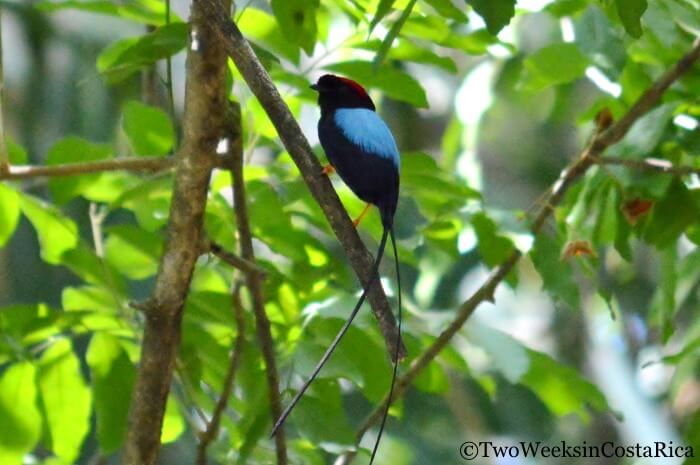
During our most recent visit, we were lucky to see a family of spider monkeys high in a tree. Spider monkeys are also rare, especially in Guanacaste, so that was another awesome sighting. In addition, we saw a few Aracari (birds in the toucan family).
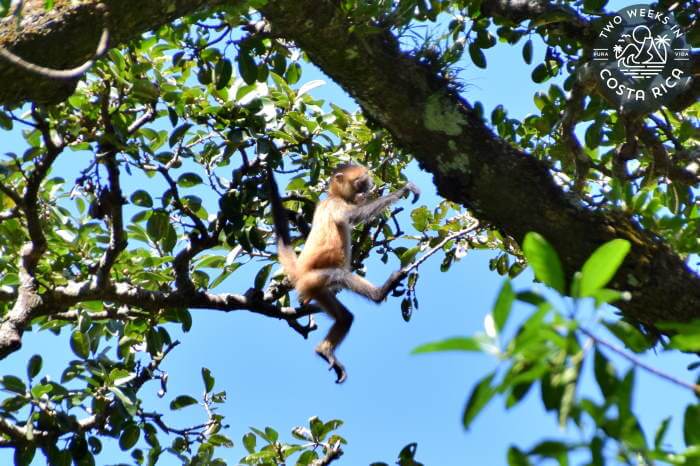
In the shadier part of the trail, you’ll find two more volcanic elements.
Mini-Volcano
The first is a mini-volcano (volcancito). Here, you can see what is like a combination of a fumarole (steam vent) and mud pot. During one of our visits, this was all dried up, but on our latest trek (with some recent rains), it was much more active. The hot steam was coming out through the soupy mud, making the mud bubble and churn.
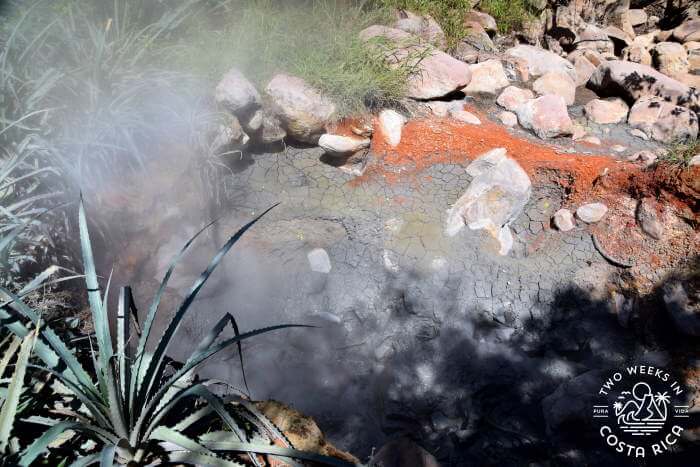
Steam Vents/Fumaroles
After a bit more hiking, there is another area with some steam vents/fumaroles. These ones are larger than the first ones along the trail and more spread out. With lots of steam rising high up into the trees, it created a cloud effect, which was very interesting.
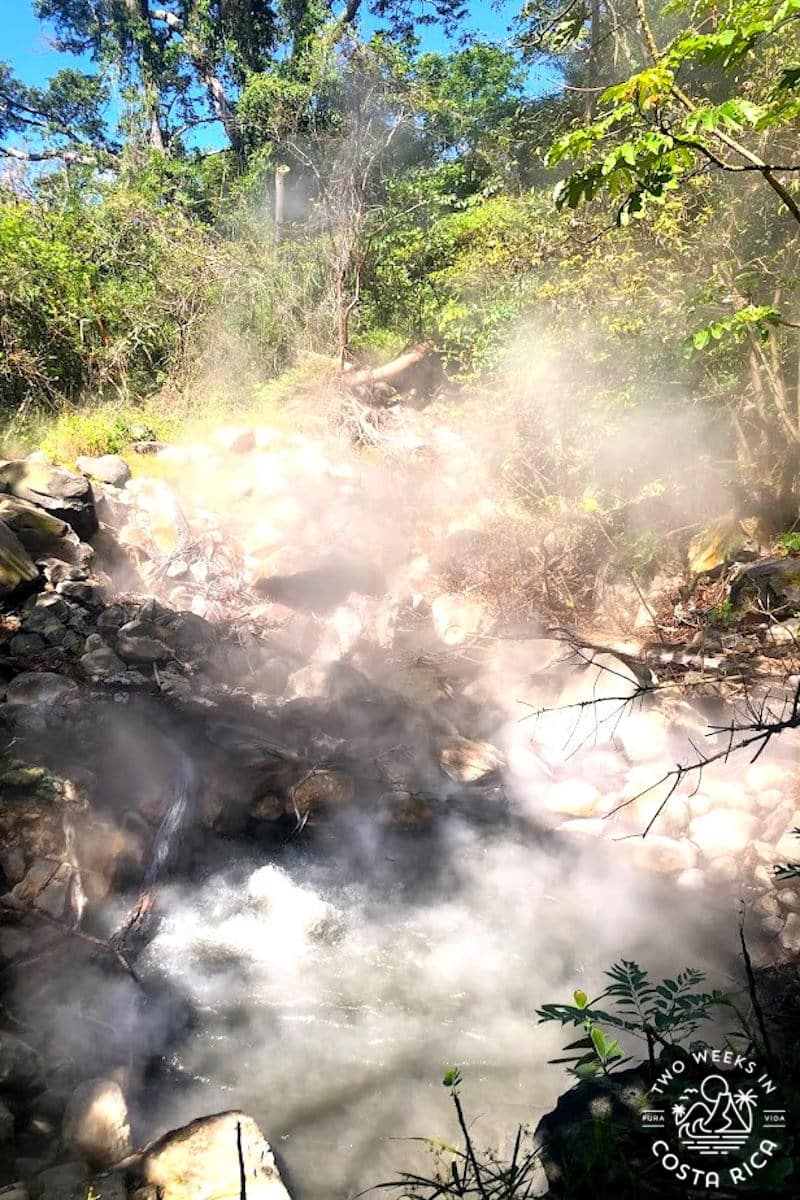
Seasonal Waterfall
The last big feature of the hike is the seasonal waterfall. During the dry season, this waterfall is usually no more than a trickle.
If it has rained recently, though, it can be quite spectacular. We caught it at a great time in late November after several days of rain. There is a nice viewing platform next to the waterfall to get some good photos as well.
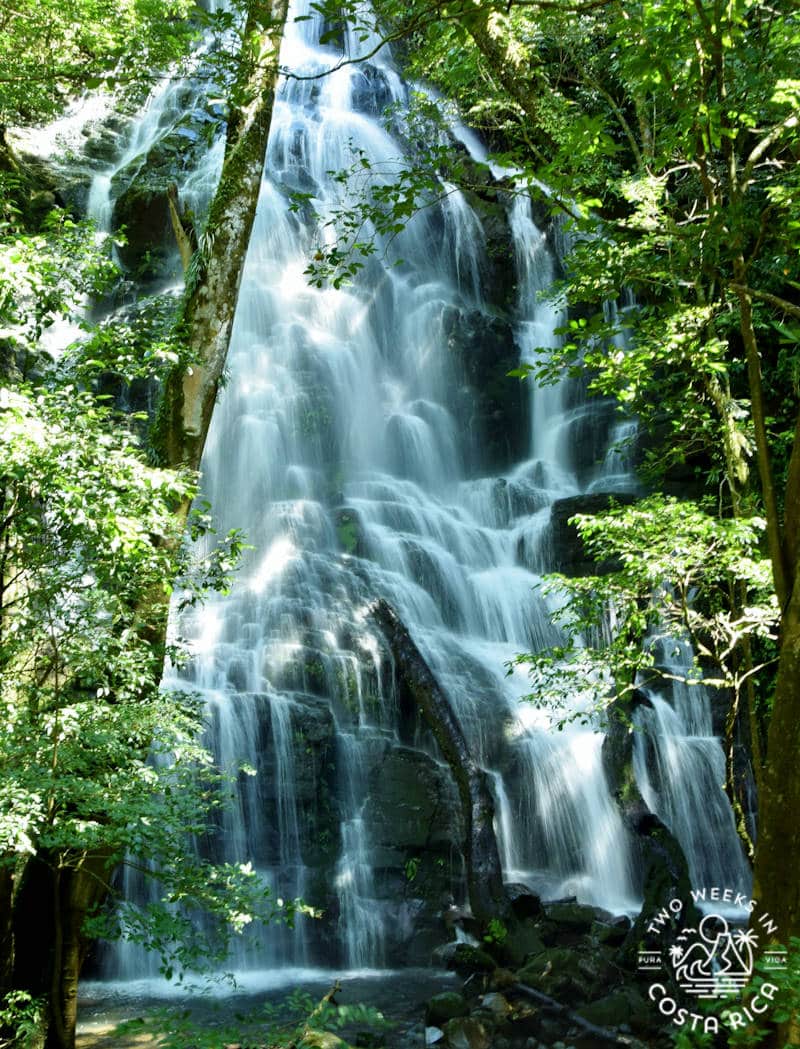
What to Wear/Bring to Rincon de la Vieja National Park
A trip to Rincon can be uncomfortable if you aren’t well-prepared. During the hotter months (January through April), we have encountered some hikers who either weren’t wearing the proper gear or didn’t bring enough water. And they didn’t hesitate to express their discomfort to us. Don’t let this happen to you!
Here are the essentials to make sure you have a great visit.
Closed-toed Shoes, Sneakers, or Hiking Boots: Although parts of the trail are flat and easy, if you do the complete loop, you will have to traverse some steeper spots. Flip-flops are not recommended.
Sun Protection: A hat and sunscreen are the most important things you will need. These will be essential for the first part of the trail when you are in direct sunlight.
Water and Snacks: The ranger station is remote and there aren’t any stores nearby. Be sure to stock up on things when passing through Liberia. Bringing plenty of water is especially important because of the heat. Temperatures often creep up over 90˚F (32˚C).
IMPORTANT: Plastic water bottles are no longer allowed in the park. Make sure to bring only reusable water bottles. The rangers will not allow you to bring in disposable ones.
Insect Repellent: Some parts of the trail are bug-free, but we did encounter a few swarms of mosquitoes near the waterfall. Definitely bring some repellent.
For specific recommendations on sunscreen, repellent, and gear, check out our post, Packing for Costa Rica: The Essentials.
Park Hours
Rincon de la Vieja’s Las Pailas sector is open Tuesday through Sunday, 8:00 a.m. – 5:00 p.m. CLOSED MONDAY.
Last entrance: 3:00 p.m.
Price
Foreigners: $15/adult. $5/child ages 2-12.
Citizens and Legal Residents: ₡1,000/adult. ₡500/child ages 2-12.
Children under 2 are free.
Buying Tickets
IMPORTANT: Tickets for Rincon de la Vieja National Park must be purchased in advance through the park service’s website. You need to register for an account first. English is available.
In-person tickets are not sold and you will be turned away or have to purchase them on your phone (if you have a signal). It’s best to buy in advance as the reservations’ system can be clunky. If the system isn’t working for you, try another internet browser like Microsoft Edge.
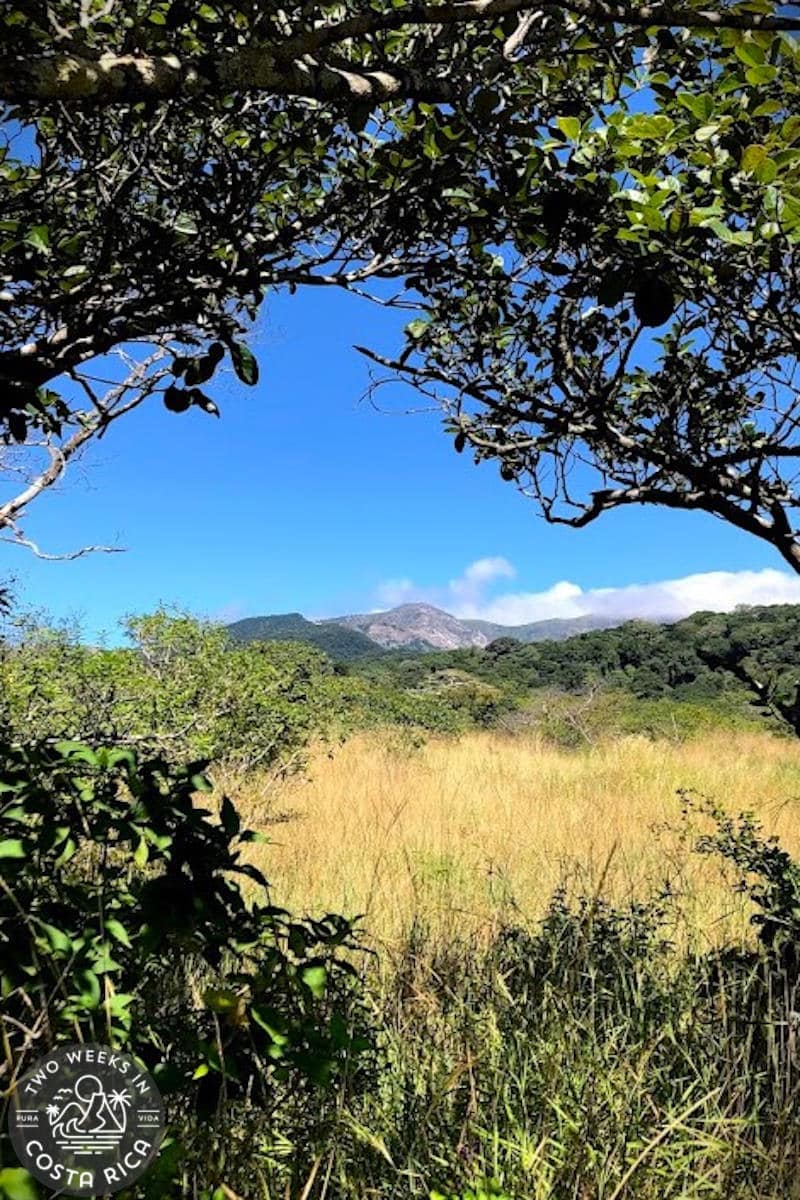
Directions to Las Pailas Sector – Rincon de la Vieja National Park
From Liberia, take the Pan American Highway (Route 1) going north. Drive 5.8 km (3 miles) and turn right at the sign for Curubande and Rincon de la Vieja National Park – Las Pailas sector. Stay on this road through the village of Curubande de Liberia. Watch for signs for Rincon de la Vieja National Park – Las Pailas sector.
Eventually, you will come to a gate and the road will turn to dirt. At the gate, you will have to pay an attendant (₡800/$1.50 per person, when we have visited) to access the private dirt road. Continue on the partially dirt/partially paved road for 20 minutes and you will come to Las Pailas parking lot and park entrance.
Tip: Although part of the road is dirt and somewhat bumpy, it is in good condition. A regular car (non-4×4) would be fine.
Have a question about Rincon de la Vieja National Park? Ask it in the comments below.
Some of the links in this post are connected to affiliate programs we have joined. As an Amazon Associate we earn from qualifying purchases.
Visiting Guanacaste during your trip? Here are more articles on things to do in the area:
Oropendola Waterfall: An Easy-to-Access Waterfall in Guanacaste – Right before the entrance to Las Pailas sector is a gorgeous waterfall that flows through a canyon. Read our post for everything you need to know about visiting.
Llanos de Cortez: Another stunning waterfall right off the highway south of Liberia. This one is great for swimming.
The Big Cats of Las Pumas Rescue Center: A wildlife rescue and rehabilitation center near Liberia with pumas, jaguars, ocelots, toucans, parrots, and many more animals.
Planning to explore other parks in Guanacaste? Here are some options:
Palo Verde National Park: This boat tour of the wetlands is great for seeing wildlife like monkeys.
Lomas Barbudal Biological Reserve: This is one of Costa Rica’s least visited parks. It stays green year-round and has a small, but scenic, waterfall.
Santa Rosa National Park: This park is known for being the site of a historic battle. You can explore the small museum to learn more.
Diria National Park: If you’re feeling adventurous, check out this off-the-beaten path spot near Santa Cruz.



